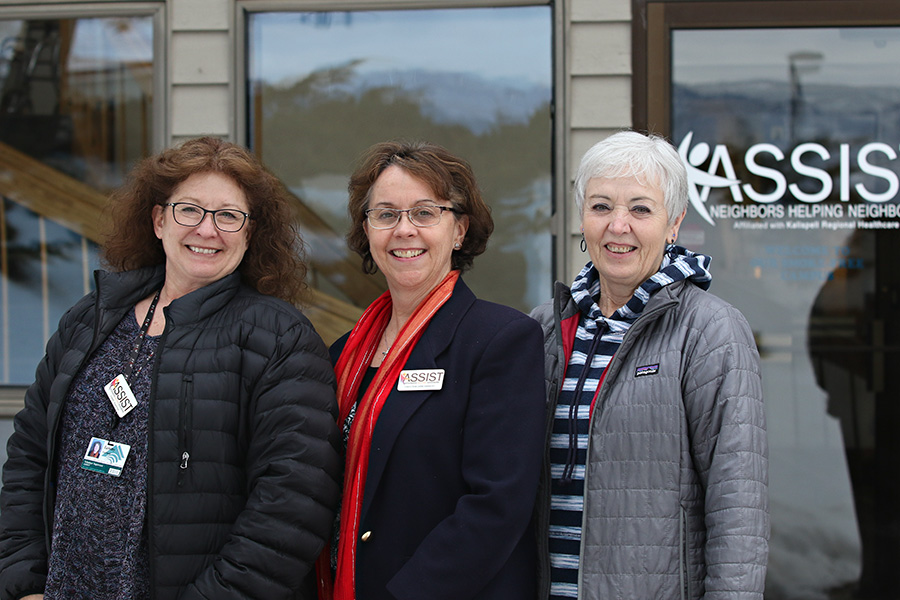Neighbors Helping Neighbors
ASSIST helps people recovering from a medical crisis to regain their health and independence; hosting workshops for people interested in volunteering on Feb. 16 and 23
By Myers Reece
It’s difficult for anybody recovering from a hospitalization or other medical crisis to get back on their feet, but it can be overwhelming, even impossible, for those without income stability or a working knowledge of navigating resources and filling out complex paperwork, or who don’t have a car or family or education, or are limited by age or health. Maybe they face a combination of those inhibiting factors and others.
Curtis Lund, a businessman and the current board chairman for Kalispell Regional Healthcare, began growing increasingly aware of these challenges a few years ago. There were cases of patients arriving at the hospital via public transportation and not understanding how to complete the paperwork upon entry. That didn’t bode well for their prospects leaving the hospital.
Then there were the patients who repeatedly returned to the emergency room for preventable illnesses because they apparently weren’t getting or taking the appropriate medications for whatever reasons. In short, people were falling through the cracks, and Lund, already an active volunteer in the valley, wanted to do something about it.
So he enlisted Jane Emmert, a local businesswoman with a knack for problem-solving and management, to help him launch ASSIST Neighbors Helping Neighbors in 2014. For the first two years, until ASSIST was taken under KRH’s nonprofit umbrella last fall, Lund funded the program by himself, with Emmert guiding it and volunteers powering it.
The Kalispell-based nonprofit has steadily grown from an idea into a critical community service, and last year it served more than 500 people across Flathead County.
“We deal with the people most likely to fall through the cracks,” Emmert said from ASSIST’s offices last week. “The cool thing about Curt is he believed in the power of volunteers to make a difference. He’s an amazing man.”
Hospitals, clinics and doctors’ offices refer patients to ASSIST who have been identified as potentially needing assistance. From there, ASSIST reaches out to the patients, listens to their stories and starts formulating ways to solve their issues. Emmert is the organization’s director and has a staff of three, but volunteers fuel the program.
There is currently a stable of 15-20 volunteers, but more are needed. The organization is growing organically, and now state budget cuts to social services, particularly case management, raise the specter of more residents in need slipping through the cracks.
ASSIST is holding two volunteer workshops on Feb. 16 and 23. The first day will be an informational introduction, and if people are interested in pursuing a volunteer position further, the second day will delve more into specific training.
Volunteers don’t need specific backgrounds. Emmert said volunteers have included retired schoolteachers, businesspeople, retired medical staff and a logger.
“We’re not medical,” she said. “You don’t have to be a social worker or medical person to volunteer with us. We are looking for problem-solving people who want to help their neighbors like a good son or daughter would.”
“It takes common sense and a willingness to meet people where they are,” she added. “We build relationships.”
The organization’s goal is to help people regain their health and independence. Many patients, though not all, are elderly and perhaps low income. This demographic is less likely to have a computer and internet connection, or know how to navigate the web. They may be recovering from any number of medical crises: surgery, a fall, illness.
Volunteers visit patients at their homes and offer “compassion, companionship and connections to resources in the community.” Those resources include financial assistance, meals, transportation, social services, home care, Medicaid and Medicare, and other “unmet needs.”
“We meet them where they’re at — whether that’s a house or a camper — and we take the time to listen,” Emmert said.
Terry Hamik, a volunteer, tells the story of a woman who was discharged from the emergency room but then kept ending up there again. ASSIST got in touch with her and learned that she lived in Hungry Horse without a car, so she couldn’t renew her prescriptions.
“It was cyclical,” Hamik said.
The organization, whose volunteers drive all around the county, made sure the woman got her medication, ending the cycle of hospitalization.
“It was just getting over that quote bump so she could get better,” Hamik said.
Emmert recalls a woman who had undergone foot surgery. The nonprofit discovered that she was spending all of the little money she had on renting her knee scooter and had none for food, so she planned to eat whatever canned vegetables she had and hope for the best. Volunteers connected her to the food bank and Meals on Wheels.
“She didn’t know where to turn,” Emmert said.
Emmert, Hamik and volunteer supervisor Tammy Harmon all point out that everybody wants their health and independence. If they aren’t achieving either, it’s not by choice. They just need a little help.
“If the people could do this by themselves, they would,” Emmert said.
The organization could serve as a model for other communities, as evidenced by Emmert fielding calls from around the country from people wanting to learn more and potentially implement a similar program where they are.
“It’s about engaging the community, because no health care system can do it all alone,” Emmert said.
For more information about ASSIST, including how to apply to be a volunteer, visit www.assistflathead.org or call (406) 758-1437.